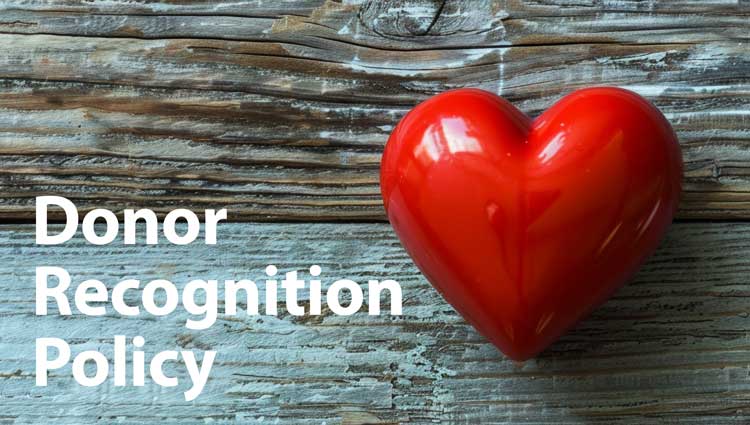
Have you thanked a donor today?
Thanking your donors early and often is an essential part of stewardship. Even the smallest gifts deserve some form of recognition—and not just because it’s good manners. That small gift may be a seed for something larger, and if you don’t water it, it will never grow. Studies have shown that a lack of recognition is one of the top five reasons that donors choose to stop giving.
But sometimes, it’s hard to decide what constitutes an appropriate expression of gratitude—and the thank-you notes never get sent. Should a $5 gift get the same response as a $5,000 gift? Hardly. Both deserve a thank-you, but one donor may be a candidate for your legacy society and a keepsake gift, while the other should simply get a “thank you” acknowledgement note. That’s why your nonprofit needs a solid donor recognition policy.
We’ll walk you through the basics of creating a donor recognition policy in this short guide. We’ll also show you the right way to express your gratitude.
The first step is to decide which gift levels get what type of acknowledgement. These numbers may vary widely depending on the size of your nonprofit. Sit down with your latest annual report and look for giving trends and average amounts. Pore over your donor rolls. Then segment gifts and donor types into different tiers along these lines:
Or, it may make more sense to create and name levels according to amounts. A smaller shop’s breakdown might look something like this:
The names of each level could be generic — bronze, silver, gold, platinum. Or you could get creative, and use names people identify with your mission. An art museum, for instance, might use “apprentice,” “emerging artist,” and “master artist.”
Once your system to identify donor levels is in place, you need to set a “thank you” timeline.
Ideally, the sooner your gratitude is expressed sent, the better. Some experts insist a thank-you must be sent within 24 to 72 hours. Others say it needs to go out no later than three weeks after the gift.
We say, err on the side of caution. While getting a note out in three days or less may be tough, a week should be plenty of time. Three weeks seems too long, and even two is stretching it.
For web donations, you can simplify the process with an autoreply that sends a heartfelt email, thanking donors immediately. For smaller gifts — say, $5 to $99 — this may be sufficient. However, you may still want to follow up with a handwritten note or more personalized email. While that $25 gift may seem like peanuts to you, it could be a much bigger deal to someone who’s living paycheck to paycheck. Remember that they still care enough to support your mission, even if it means a personal sacrifice.
At the bare minimum, you should acknowledge each type of donor with a timely (within a week or less), personalized thank-you note or email along with their donation receipt. To demonstrate their impact, mention what their donation will be used for. When possible, include engaging and relevant pictures from your mission.
For example, at the “Friends” level, you might include a picture of smiling children reading in a classroom setting with a note that states,
Dear Paul,
Thank you for your $25 donation to our annual book fair campaign. Your gift will allow us to purchase two books for our kindergarten literacy program. Thanks to people like you, we’re helping more than 200 children a year learn essential reading skills.
For the “Family” level, you might send a longer thank-you note signed by the nonprofit’s director, and provide recognition in your annual report.
“Champions” might earn entry into your legacy society, annual report, and a mention on social media (in addition to a longer thank-you note or a phone call).
“Founders” could get exclusive access to your nonprofit’s behind-the-scenes work or a special event; a plaque or naming rights; entry into your legacy society; a story in your newsletter or annual report; a social-media shoutout, and (of course) a handwritten, heartfelt thank-you note. An immediate phone call would also be a good idea.
And what about your volunteers? We recommend sending them a thank-you letter shortly after they start; and at least once a year after that. Show your appreciation in other ways, too — a pizza party, tickets to one of your events, exclusive access to a side of your mission the general public doesn’t get to experience. Don’t neglect your volunteers, or take them for granted. You’ll miss them when they’re gone.
It’s just as important to acknowledge corporate donations/sponsors, and grants from foundations—there are, after all, people behind these gifts. Maintaining good relationships with them is crucial.
For corporations, send a handwritten thank-you note. Be sure to use the company’s name in the salutation: i.e., “Dear Acme Corporation.” Then, in the body of the letter, give a shout-out to anyone at the company who was instrumental in facilitating the gift. Mention the gift’s impact (add photos, too) and thank them for their partnership.
For a foundation, your thank-you should be twofold: One to the foundation’s board chair, program officer, or CEO, and one meant for the donor who facilitated the gift. In both cases, thank them for choosing your organization. And as with every other “thank you” here, include examples of what the gift will accomplish. Include pictures when possible.
If you’re including a tax acknowledgment letter (receipt) with your thank-you note, yes. For gifts valued over $250, the IRS requires that the receipt include:
*or*
While not legally required, experts also recommended including:
A prompt, genuine thank you is a must after every donation, no matter the gift amount. When thanked properly, donors feel appreciated and feel that their gifts were meaningful. Ensuring that supporters are thanked properly can significantly improve donor retention and shorten the length of time between gifts.
A donor recognition policy that identifies the appropriate level of public or private recognition simplifies this process and augments your stewardship efforts.

Hands-on, in-the-trenches experience designed to equip you with strategies and skills for success. Choose the one that fits your goals—or take both for maximum results. It’s intense, effective, and built for leaders like you.
Related
Educate donors and build instant credibility, authority and trust with our planned giving micro website.
800.490-7090
484.680.7800 local
Succeed@MajorGifts.com
Stay Informed!
Webinars, free downloads, tax law changes, more. Subscribe today. You can unsubscribe at anytime.
Copyright 2024 © PlannedGiving.Com
Stay informed with timely news. You can unsubscribe at any time.
Success List